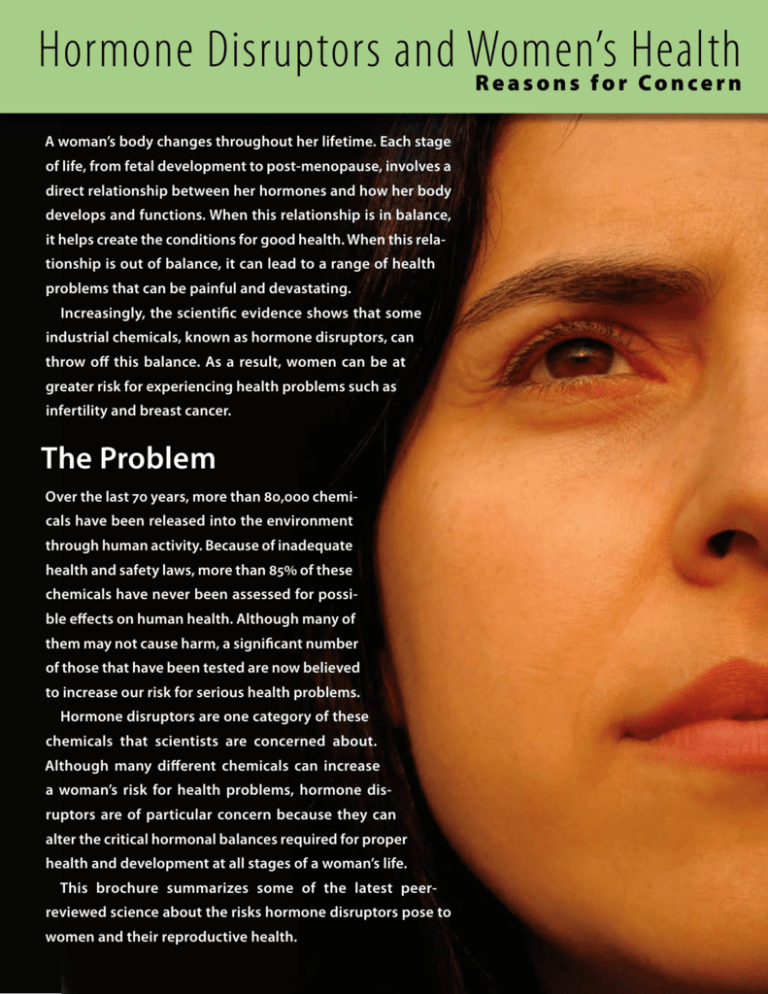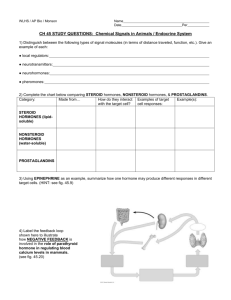Hormone Disruptors and Women's Health
advertisement

Hormone Disruptors and Women’s Health Reasons for Concern A woman’s body changes throughout her lifetime. Each stage of life, from fetal development to post-menopause, involves a direct relationship between her hormones and how her body develops and functions. When this relationship is in balance, it helps create the conditions for good health. When this relationship is out of balance, it can lead to a range of health problems that can be painful and devastating. Increasingly, the scientific evidence shows that some industrial chemicals, known as hormone disruptors, can throw off this balance. As a result, women can be at greater risk for experiencing health problems such as infertility and breast cancer. The Problem Over the last 70 years, more than 80,000 chemicals have been released into the environment through human activity. Because of inadequate health and safety laws, more than 85% of these chemicals have never been assessed for possible effects on human health. Although many of them may not cause harm, a significant number of those that have been tested are now believed to increase our risk for serious health problems. Hormone disruptors are one category of these chemicals that scientists are concerned about. Although many different chemicals can increase a woman’s risk for health problems, hormone disruptors are of particular concern because they can alter the critical hormonal balances required for proper health and development at all stages of a woman’s life. This brochure summarizes some of the latest peerreviewed science about the risks hormone disruptors pose to women and their reproductive health. Hormones and Hormone Disruptors Hormones regulate a wide range of functions in our bodies. Hormone disruptors* can interfere with these functions. Hormones Hormone Disruptors Clear Messages Mixed Messages Pineal Parathyroids Hypothalamus Pituitary gland Thyroid (behind thyroid gland) Thymus Adrenal gland Stomach Kidney Pancreas Duodenum Ovary Hormones are produced by the endocrine system, Hormone disruptors are substances not naturally What the y are What the y do which includes the ovaries (women), testes (men), found in the body that interfere with the production, pituitary, thyroid, pancreas and other parts of the body. release, transport, metabolism, binding, action or They are then secreted into the blood as chemical elimination of the body’s natural hormones. Phthal­ messengers. Examples of hormones include adrenaline, ates, Bisphenol A (BPA) and DDT are some of the more estrogen, insulin, thyroid hormones and testosterone. commonly known hormone disruptors. Hormones direct communication and coordination Hormone disruptors can scramble messages that among tissues throughout the body. For example, natural hormones transfer between cells. Usually hor­ hormones work with the nervous system, reproduc­ mones bind to hormone receptors like a lock and key. tive system, kidneys, gut, liver and fat to help maintain When the key fits, it unlocks the process of sending and control body energy levels, reproduction, growth messages to regulate functions in the body. Hormone and development, internal balance of body systems disruptors can interfere with this process. For example, (called homeostasis) and responses to surroundings, some can mimic natural hormones and bind to the stress and injury. receptors, unlocking the process but sending the wrong message. * Hormone disruptors are also referred to as endocrine disruptors. The Complexity of Health No formula currently exists that can determine the exact effects hormone disruptors will have on a woman’s health. Research indi­ cates that the effects depend on the potency and dose of the chemical, the timing of the exposure and the individual’s overall health, which can be shaped by her genetic makeup, diet, exercise habits, racial and economic disparities, sexually transmitted diseases, access to health care and many other factors. How We Are Exposed People can be exposed to hormone disruptors indoors and outdoors, at home and in the workplace. Hormone disruptors get into our bodies when we breathe, eat, drink and have skin contact with them. They can be found in household products such as cosmet­ ics and plastic containers. They can come from industrial pollution and cigarette smoke. Some pesticides are hormone disruptors and can end up on our food and in our waterways. Below are a few examples of hormone disruptors. More research is needed to identify all hormone disruptors and their potential health impacts. Examples of Hormone Disruptors Atrazine Atrazine is one of the most heavily used herbicides in the U.S. and is widely applied to corn and soy crops. It is banned in the European Union due to concerns of ground water contamination. BPA Bisphenol A (BPA) is commonly used in some plastic products such as sports bottles and baby bottles, in addition to the linings of canned food and infant formula. Cigarette Smoke First and Secondhand DDT Cigarette smoke contains hundreds of chemicals, including some hormone disruptors. More research is needed to fully understand how cigarette smoke affects hormone function. This research is especially important because cigarette smoke is very common and because so many health problems are associated with it. The pesticide dichloro diphenyl trichloroethane (DDT) was widely used in the U.S. until it was banned in 1972 due to toxicity. DDE, a byproduct from the breakdown of DDT is also harmful. DDT is still used in some other countries, often to eliminate mosquitoes associated with malaria risk. DES Diethylstilbestrol (DES) is an estrogenic compound that was first manufactured in 1938 and was prescribed to prevent miscarriages. It is no longer used for this purpose because of the associated health risks. Dioxins Dioxins are the byproducts of some manufacturing and incineration processes. The uncontrolled burning of resi­ dential waste is thought to be among the largest sources of dioxins in the United States. PBBs Polybrominated biphenyls (PBBs) were used as a flame retardant in electrical appliances, textiles, plastic foams and other products. In 1976 the manufacturing of PBBs ended in the U.S. after they contaminated milk supplies. PCBs Polychlorinated biphenyls (PCBs) are a class of compounds that were used as coolants and insulation in electrical equipment, in coating of electrical wiring and for many other purposes. They were banned in the 1970s due to their toxicity. Phthalates Phthalates are a family of compounds used as a plasticizer in PVC (vinyl), cosmetics, fragrance and medical devices. Some phthalates were banned from children’s products in 2008. Some hormone disruptors such as DDT and PCBs were banned more than 30 years ago but persist in the environment, animals and our bodies. Women’s Reproductive Health Concerns Animal studies designed to predict human harm, as well as a limited number of human studies, have helped researchers understand some of the ways hormone disruptors can increase risk for various health problems. More research is needed, but below are descrip­ tions of some of these health problems and examples of associated hormone disruptors (in italics). Early puberty is a growing concern. In the U.S. girls get their first periods a few months earlier than they did 40 years ago, and they develop breasts one to two years earlier. Early puberty has been associated with polycystic ovar­ ian syndrome, obesity, breast cancer, depression and a number of social chal­ lenges such as experimentation with sex, alcohol or drugs at a younger age. Phthalates, BPA, some pesticides such as DDT, PCBs, PBBs, cigarette smoke and DES. Impaired fertility or infertility i ncludes difficulty or the inability to get pregnant and/or carry a pregnancy to term. It is difficult to say for certain how many people experience impaired fer­ tility, but the best estimate is 12% of the reproductive age population in the U.S. This number seems to have increased over the last two decades, most sharply in women under the age of 25. Men­ strual irregularities and male infertility contribute to this problem, as well as other specific health concerns, which are listed below. DDT, cigarette smoke, phthalates and PCBs. Polycystic ovarian syndrome (PCOS) symptoms include irregular periods, pel­ vic pain and ovarian cysts. Women with PCOS have a higher risk of developing insulin resistance, diabetes, endome­ trial cancer, infertility, miscarriage and hypertension. BPA. Uterine fibroids occur in 25% to 50% of all women, though some estimates are much higher. Fibroids are the num­ ber one cause of hysterectomy in repro­ ductive age women and can cause pelvic pain, abnormally heavy periods, abnor­ mal uterine bleeding, infertility and com­ plications in pregnancy. DES and BPA. Endometriosis occurs when the tissue that lines the inside of the uterus (called the endometrium) grows outside the uterus on other parts of the body, for example the ovaries, abdomen and pel­ vis. Estimates vary, but most studies find between 10% and 15% of reproductiveage women have endometriosis. About 30% to 40% of women with endometri­ osis are infertile, making it one of the leading contributors to female infertil­ ity. DES, dioxins, phthalates and PCBs. to the bonding and nurturing process. PCBs and pesticides such as Atrazine or DDT/DDE. Breast cancer incidence rates in the United States increased by more than 40% between 1973 and 1998. In 2008, a woman’s lifetime risk of breast cancer is one in eight. More than 200 chemi­ cals, including numerous hormone disruptors, have been associated with increased incidence of breast tumors. DES, BPA, first- or second-hand smoke and some pesticides, especially early life exposure to DDT. Miscarriage affects up to 21% of known pregnancies and can be caused by a variety of factors, especially abnor­ mal chromosomes (known as aneu­ ploidy). BPA, cigarette smoke and pesticides such as DDT. Hormone Disruptors and Men’s Health. This report focuses on the risks of hormone disruptors and women’s health, but these chemicals also pose risks to males, especially from exposures in the womb. Some of these risks include hypospadias (a birth defect of the penis), cryptochordism (undescended testicles), impaired fertility from reduced sperm count and semen quality, and some cancers, including testicular and pros­ tate cancer. Shortened lactation, or reducing how long a woman can breastfeed her baby, can have long-term impacts on the child, including increased risk for infection, chronic disease, compromised immunity and obesity. Breastfeeding helps build a child’s immune system and later intelligence and is important Hormone disruptors are not the only type of chemicals that can harm wom­ en’s health. Solvents, air pollution, heavy metals such as lead and mercury and many other contaminants can harm people’s health. To learn about other environmental contaminants, see the references at the end of this brochure. What We Are Learning Research into hormone disruptors is changing our understanding of health risks. Traditional schools of thought are evolving to reflect the complexity of how chemicals impact our health. Some trends in the research findings include: Timing of Exposure Throughout a woman’s lifetime, reproductive organs develop and change. Stages of rapid develop­ ment can be especially vulnerable to the effects of hormone disruptors, and exposure at these times can increase risk for health problems later in life. For example, exposure to some hormone disruptors before birth can increase the chance for early puberty, infertility and breast cancer. Generational Effects Hormone disruptors can cause multi-generational harm. The clearest example of this is DES, a drug given to pregnant women for many years to prevent miscarriage (though it was ineffective). Many DES daughters experience infertility and cancer in their reproductive organs and breasts. Animal stud­ ies show that the granddaughters of women who took DES are also at risk for ovarian and uterine cancers. Level of Exposure For years it was assumed that everyday levels of chemical exposure would not harm our health, but emerging research calls this into question. For example, some studies have found that low levels of BPA can harm reproductive health in female mice and their offspring. More research is needed to fully understand how BPA impacts humans, but the Centers for Disease Control detected BPA in nearly 93% of the people they tested, raising new questions about its widespread use. Hormone Activation Levels. Natural or synthetic hormones can activate changes at very low levels. This graph shows normal levels of natural estrogen (estradiol) in women and levels of synthetic estrogen (ethinyl estradiol) and progestin (desogestrel) in women taking birth control. These levels are adequate to activate significant functions, such as regulating menstrual cycles and preventing pregnancy. BPA, which can mimic natural estrogen, can be found in the body under normal conditions at the same or higher levels than these natural or synthetic hormones. Natural estrogen in women of reproductive years Synthetic estrogen in women using birth control pills Synthetic progestin in women using birth control pills* BPA in women Levels (parts per trillion) 0 100 * Levels of 3-keto-desogestrel, the metabolite of desogestrel. 200 300 400 500 600 700 800 900 1000 4010 What We Can Do We know enough about hormone disruptors to know we have a problem. A coordinated effort between researchers, elected officials, advocates, medical professionals, business leaders and the general public is needed to ensure that we are not put­ ting our families and future generations at undue risk. Some of the things we can do are: Support better research on hormone disruptors, including: • Prioritize research funding to study the effects of hormone disruptors on women’s health. Most of the research to date has been focused on hormone disruptors and men, leaving more gaps in the research on women’s health. • Improve health tracking systems. Currently the systems that track rates of various health problems are inadequate. In order to understand the full impact of hormone disruptors on human health, collecting this information is critical. • Support long-term studies. Because hormone disruptors can have life-long impacts, it is especially important to initiate stud­ ies tracking women’s health over large spans of their lives. This will help us understand long-term and multi-generational effects. Support policies to prevent exposure to hormone disruptors and other chemicals that have not been proven safe. Current standards for chemical use do not adequately protect us. New national policies are needed to identify and phase out harmful chemicals and to require that safer substitutes be used. Use healthier products when possible. There are many easy, affordable and simple changes anyone can make at home to reduce their exposure to environmental contaminants. For ideas on how to make these changes, please see www.womenshealthandenvironment.org. Crain, AD, Janssen, S. et al. Female reproductive disor­ ders: The roles of endocrine disrupting compounds and developmental timing. Fertility and Sterility; expected publication Fall 2008. Other references used to support the development of this report include: Proceedings from the Summit on Environmental Chal­ lenges to Reproductive Health and Fertility. Hosted by the University of California, San Francisco and the Col­ laborative on Health and the Environment. Fertility and Sterility 2008;89:e1-e20. www.prhe.ucsf.edu/prhe/ events/ucsfche_fs.html. These and many other resources document how hormone disruptors and a wide range of other contaminants can harm people’s health. For full documentation of this brochure, see www.healthandenvironment.org/ reprohealthworkshop. The workshop was co-sponsored by the Collaborative on Health and the Environment (CHE), the University of Florida (UF) and the University of California, San Francisco’s Pro­ gram on Reproductive Health and the Environment (PRHE). This event was co-chaired by Dr. Louis Guillette at UF (www.zoology.ufl.edu/ljg) and Dr. Linda Giudice at PRHE (www.prhe.ucsf.edu). Please contact these individuals for further information about this research. Thanks to Sarah Janssen of Natural Resources Defense Council for contributing to this brochure. Written by Heather Sarantis. Funding for this project was provided by John Burbank and Alison Carlson, the Barbara Smith Fund, the Johnson Family Foundation, The New York Community Trust and Turner Foundation, Inc. For copies of this brochure or for more information please contact CHE (www. healthandenvironment.org). ALTH AND HE E ENVIRON TH Shaping Our Legacy: Reproductive Health and the Envi­ ronment. A report on the Summit on Environmental Challenges to Reproductive Health and Fertility, January 28–30, 2007. www.prhe.ucsf.edu/prhe/pubs/shapingour­ legacy.pdf. This report summarizes the key outcomes of the Women’s Reproductive Health and the Environment Workshop held at Commonweal in Bolinas, CA, January 6–9, 2008. Results are published in “Female reproductive disorders: The roles of endocrine disrupting com­ pounds and developmental timing.” (See References for full citation). RATIVE O N BO References for this report were taken from peer-reviewed sources that summarize the links between hormone dis­ ruptors and women’s heath. The primary source was: NT • COLL A ME References Printed on New Leaf Reincarnation Matte paper. FSC-certified, 100% recycled, 50% post-consumer content, processed chlorine free. Design by half-full (www.half-full.org).









